Welcome to our comprehensive guide on caring for and promoting the growth of Vallisneria Spiralis in freshwater aquariums.
As passionate aquarists, we understand the appeal of incorporating beautiful aquatic plants like Vallisneria Spiralis into our tanks.
In this guide, we will provide you with expert tips and advice to ensure that your Vallisneria Spiralis thrives in its aquatic habitat.
Vallisneria Spiralis, also known as straight Vallisneria or tape grass, is an exotic aquatic plant in the family Hydrocharitaceae.
Its long, narrow leaves and cluster growth pattern make it an attractive addition to any freshwater aquarium.
Not only does it enhance the tank’s aesthetic appeal, but it also provides numerous benefits to the overall ecosystem.
Whether you are a beginner or an experienced aquarist, this guide will equip you with the knowledge and strategies to successfully cultivate and maintain Vallisneria Spiralis.
Let’s dive in and explore the fascinating world of Vallisneria Spiralis care!
Key Takeaway
- Vallisneria Spiralis is an exotic aquatic plant that enhances the beauty of freshwater aquariums.
- Understanding its natural habitat, lighting needs, and water conditions is crucial for successful care and growth.
- Proper substrate, tank size, and tank mates contribute to the plant’s overall health and aesthetic appeal.
- Regular maintenance, including pruning and nutrient supplementation, is essential for Vallisneria Spiralis’ longevity.
- Cultivating Vallisneria Spiralis at home is a rewarding experience that requires patience and proper care.
Quick Stats
| Attribute | Details |
| Scientific Name | Vallisneria spiralis |
| Common Name | Straight Vallisneria, Italian Vallisneria |
| Origin | Europe, Asia, Africa |
| Height | 30-100 cm (12-40 inches) |
| pH Range | 6.5 – 8.5 |
| CO2 Requirement | Low to Medium |
| Growth Rate | Moderate to Fast |
| Care Level | Easy |
| Color Form | Green |
| Water Conditions | 18-28°C (64-82°F), adaptable to various water parameters |
| Max Size | Typically reaches up to 100 cm (40 inches) in height |
| Lighting | Low to High |
| Supplements | Root tabs or liquid fertilizers beneficial |
| Placement | Background |
| Propagation | Through runners or division of rhizome |
What Is Vallisneria Spiralis?
Vallisneria Spiralis, also known as straight Vallisneria or tape grass, is an exotic aquatic plant in the family Hydrocharitaceae.
It is characterized by its long, narrow leaves that grow in clusters from the roots.
Vallisneria Spiralis is highly valued in the aquarium hobby due to its ability to create a lush and vibrant aquascape. Its attractive appearance and ease of care make it a popular choice among aquarists.
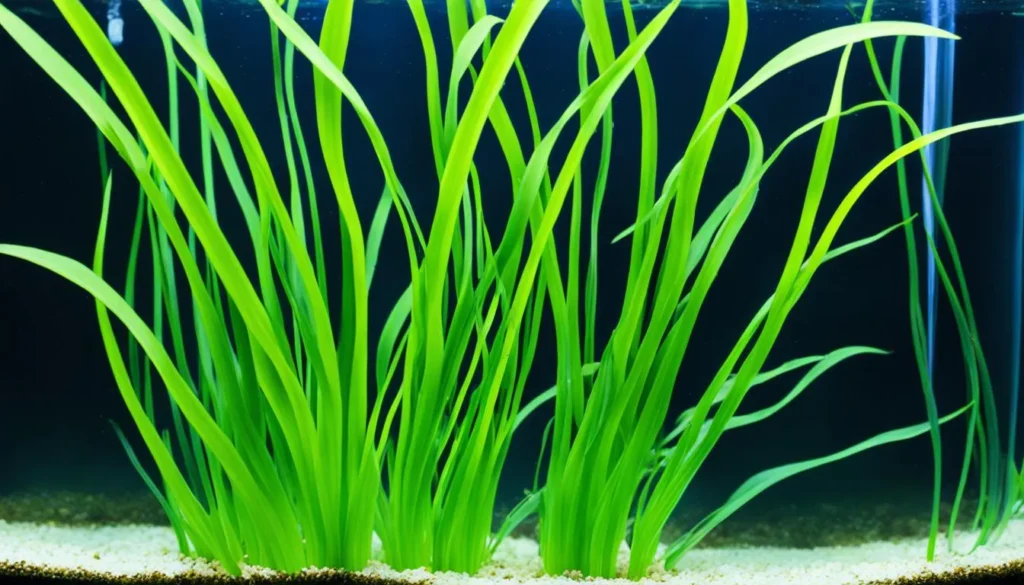
Natural Habitat And Origin
Vallisneria Spiralis, also known as tape grass, is native to various regions around the world, including North America, Europe, and Asia.
It is commonly found growing in freshwater habitats such as rivers, lakes, and ponds.
This aquatic plant thrives in areas with moderate to strong water flow and prefers nutrient-rich substrates.
Understanding the natural habitat of Vallisneria Spiralis is crucial for successfully cultivating it in aquariums.
By mimicking the ideal conditions found in its native habitats, aquarists can provide an environment that promotes the plant’s growth and overall well-being.

Physical Characteristics
- Vallisneria Spiralis showcases an array of physical characteristics that contribute to its allure as an aquatic plant species. As its name suggests, the plant boasts long, **straight leaves** that resemble tape grass, providing an elegant and natural appearance in the aquarium.
- These leaves grow in **clusters**, with multiple leaves emerging from a single root, creating a lush and visually appealing display. The leaves feature a distinct round tip and raised veins, adding texture and depth to the plant’s overall aesthetic. Depending on the specific variety and environmental conditions, Vallisneria Spiralis can grow to varying heights, offering versatility in aquascape designs.
RELATED: Unveiling The Charm Of Phyllanthus Fluitans In Aquascape
Lighting Needs Of Vallisneria Spiralis
- Energy Efficiency: LED lights are known for their energy efficiency. They consume less electricity and produce less heat than traditional lighting options. This makes them cost-effective and reduces the risk of overheating the aquarium water.
- Customizable Spectrum: LEDs allow for flexibility in adjusting the light spectrum. This feature enables you to mimic natural sunlight and provide the specific wavelengths of light required for optimal Vallisneria Spiralis growth.
- Long Lifespan: LED lights have a longer lifespan compared to other lighting options. This means less frequent replacement and greater convenience for maintaining the ideal lighting conditions for your aquarium.
- Low Heat Output: LED lights produce minimal heat, reducing the risk of overheating the water and creating an unpleasant environment for your aquatic plants and livestock.
Water Condition For Proper Growth
- Maintaining suitable water conditions is vital for the proper growth of Vallisneria Spiralis. The plant thrives in freshwater aquariums with stable water parameters.
- It can tolerate a wide range of water hardness levels, but it prefers slightly harder water with a higher pH.
- Regular water testing and monitoring are necessary to ensure the water parameters remain within the ideal range for the plant’s health and growth.
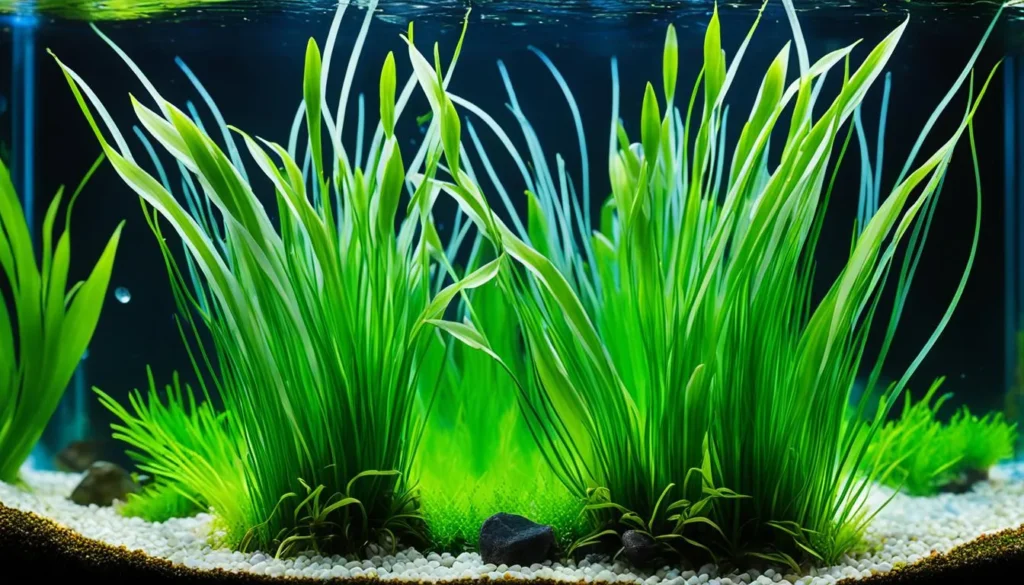
Temperature Parameters For The Plant
- Vallisneria Spiralis is a versatile aquatic plant that can adapt to a wide range of temperatures commonly found in freshwater aquariums. However, to ensure optimal growth and well-being, it is important to maintain a stable temperature within the recommended range.
- The ideal temperature for Vallisneria Spiralis is between 72°F and 82°F. This range provides the plant with the necessary conditions to thrive and prevent stress. Consistency in temperature is crucial to promote healthy growth and prevent any fluctuations that could adversely affect the plant’s development.
- To regulate and maintain the desired temperature for Vallisneria Spiralis, we recommend using a reliable aquarium heater. This ensures precise control over the aquarium’s temperature, providing the plant with a stable environment that mimics its natural habitat.
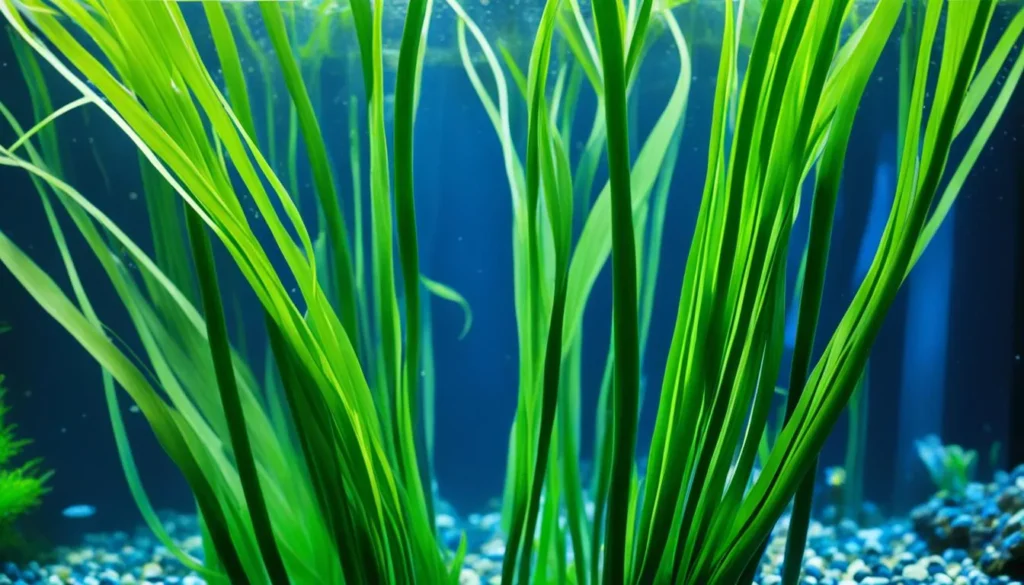
Substrate Requirements
- Vallisneria Spiralis, being a nutrient-dependent plant, requires a nutrient-rich substrate for proper root development and nutrient uptake. A fine-grained substrate, such as nutrient-rich aquarium soil or clay-based substrates, is ideal for creating an ideal growing environment for Vallisneria Spiralis. The substrate should be deep enough to allow the roots to anchor securely and provide stability for the plant.
- Regular supplementation with root tabs or liquid fertilizers can also help ensure the plant receives essential nutrients for growth. These fertilizers provide a balanced mix of micro and macronutrients to support the plant’s overall health and development. Aquarists can use a quality substrate and supplement it with appropriate fertilizers to provide Vallisneria Spiralis with the ideal conditions it needs to thrive in the aquarium.
Recommended Tank Size
- Vallisneria Spiralis can be grown in various tank sizes, from small aquariums to larger setups. However, sufficient space is recommended for the plant to spread and grow.
- For smaller tanks, Vallisneria Spiralis can be planted in the background to create a lush backdrop. It can be used as a foreground or midground plant in larger tanks, depending on the desired aquascape design.
Suitable Tank Mates
- Vallisneria Spiralis is compatible with a wide range of fish and invertebrates. It provides excellent cover and hiding spots for small fish and fry, making it an ideal choice for community aquariums.
- Some suitable tank mates for Vallisneria Spiralis include peaceful community fish like tetras, rasboras, gouramis, and livebearers. It is important to consider the specific requirements and temperament of the fish and ensure they are compatible with Vallisneria Spiralis.
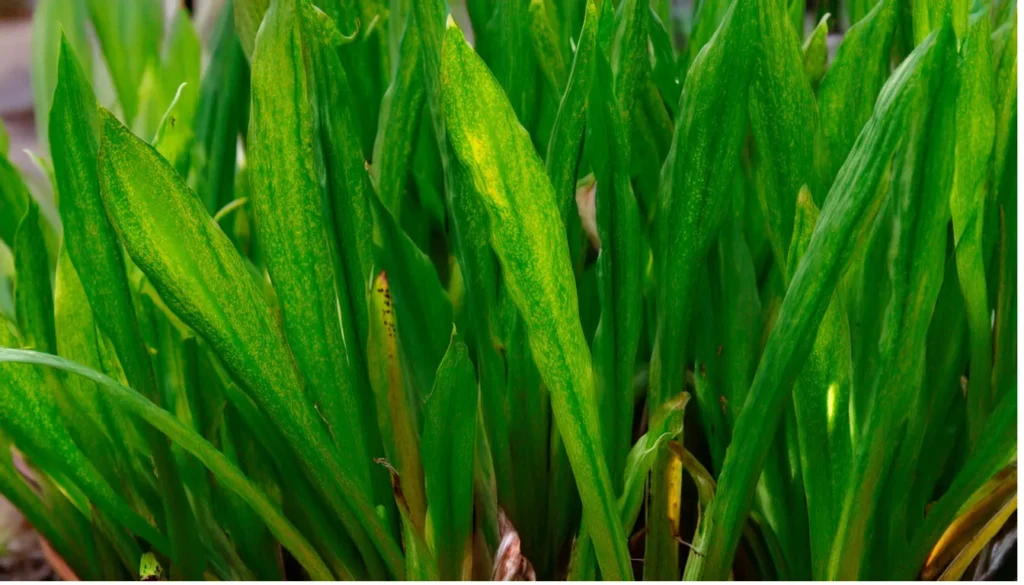
Placement Options In The Tank
- Vallisneria Spiralis, with its long, straight leaves and lush appearance, offers various placement options within the aquarium to create stunning aquascapes. Whether you want to create a vibrant background, a captivating midground, or an eye-catching foreground, Vallisneria Spiralis can be strategically placed to enhance the visual appeal of your tank.
- One popular placement option is to use Vallisneria Spiralis as a background plant, creating a dense green wall that adds depth and dimension to the aquarium. By planting the Vallisneria Spiralis in clusters at the back of the tank, you can create a lush backdrop that makes the fish and other aquatic creatures stand out.
- In larger tanks, Vallisneria Spiralis can also be used as a midground or foreground plant. By carefully arranging the plant in clusters closer to the front of the tank, you can add visual interest to the mid or foreground and create a captivating focal point. This placement option allows you to showcase the intricate details of the Vallisneria Spiralis leaves and provides a natural habitat for fish and other tank inhabitants.
RELATED: Nymphaea Tiger Guide For Optimal Care, Cultivation, And Beauty
Nutritional Requirements
Vallisneria Spiralis, like any other plant, has specific nutritional requirements that must be met to ensure optimal growth and health.
These requirements include micro and macronutrients essential for the plant’s metabolic processes and overall well-being.
Micro Nutrients
- Iron: Iron is necessary for chlorophyll production, which is essential for photosynthesis.
- Manganese: Manganese is involved in enzyme activity and helps in the synthesis of chlorophyll.
- Zinc: Zinc plays a vital role in various metabolic processes and enzyme functions within the plant.
Macro Nutrients
- Nitrogen: Nitrogen is crucial for protein synthesis and promotes the overall growth of the plant.
- Phosphorus: Phosphorus is necessary for energy transfer and the development of roots and flowers.
- Potassium is involved in various plant functions, including water regulation and stress tolerance.
Plant Maintenance Tips
- Regular pruning: Control the growth of Vallisneria Spiralis by trimming excess foliage. This prevents overcrowding and allows for optimal nutrient absorption.
- Remove dead or decaying leaves: Promptly remove any dead or decaying leaves from the plant. This helps maintain water quality and prevents the spread of bacteria or algae.
- Water changes: Regularly perform water changes to keep the aquarium environment clean and balanced. This helps remove accumulated toxins and provides fresh, oxygenated water for the plants.
- Substrate cleaning: Clean the substrate of your aquarium to prevent the buildup of debris and organic matter. This promotes a clean and healthy environment for Vallisneria Spiralis to grow and thrive.
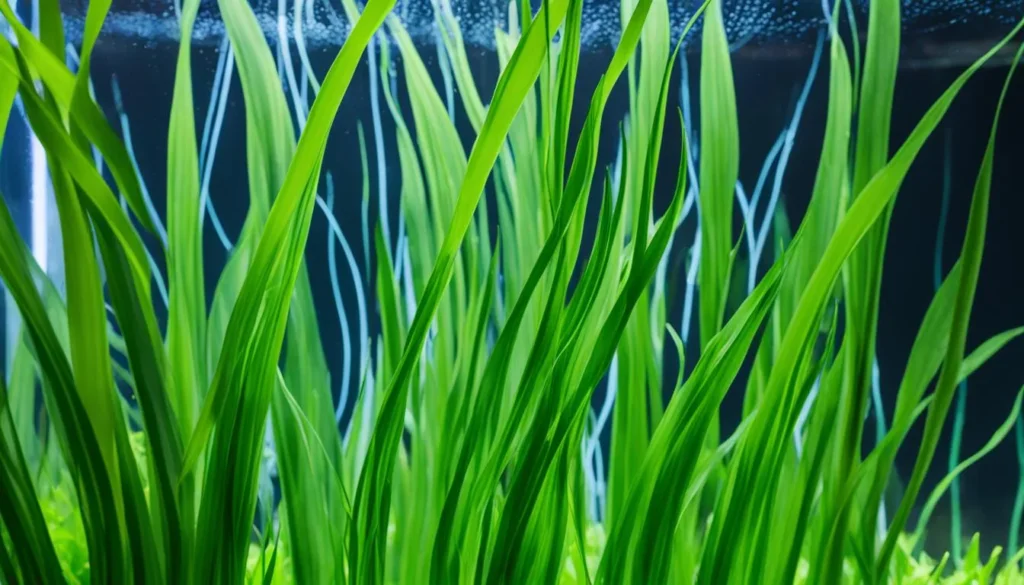
Cultivating Vallisneria Spiralis At Home
- Cultivating this plant at home is a rewarding experience for aquarists. With its stunning appearance and ease of care, this exotic aquatic plant is a popular choice for home aquariums.
- To propagate this plant, aquarists can take advantage of its natural ability to produce runners. These runners are lateral shoots that emerge from the main plant and develop their own roots and leaves. Aquarists can establish new Vallisneria Spiralis plants by separating and replanting these runners and expanding their aquatic garden.
- Successful cultivation of Vallisneria Spiralis requires proper care and maintenance. Firstly, it is important to provide suitable lighting for the plant. Moderate to high light levels are ideal to support photosynthesis and promote optimal growth.
- The water conditions should also be carefully monitored. Maintaining stable and freshwater parameters, with a slightly higher pH and nutrient-rich substrate, will promote healthy growth and development.
Plant Propagation Tips
This plant can be propagated through various methods to expand your collection of these stunning aquatic plants.
Two common propagation methods are through runners and plant division.
Runners
- Runners are lateral shoots that extend from the main Vallisneria Spiralis plant. These runners develop their own roots and leaves, making them ideal for starting new plants. To propagate this plant using runners, carefully separate the runners from the main plant.
- Choose healthy and well-established runners, ensuring they have sufficient roots and leaves. Once separated, replant the runners in the substrate of your aquarium, giving them the space they need to establish themselves as new plants.
Plant Division
- Plant division involves splitting the main Vallisneria Spiralis plant into multiple sections, each with its own set of roots and leaves. This method allows you to create multiple independent plants from one parent plant. When dividing this plant, ensure each section has enough roots and leaves to sustain its growth.
- Gently separate the sections, taking care not to damage the roots or leaves. Plant the divided sections in the substrate of your aquarium, providing them with the necessary conditions for successful growth.

Benefits Of Planting Vallisneria Spiralis
- Planting this plant in the aquarium offers numerous benefits. It enhances the overall aesthetics of the tank, creating a lush and natural-looking environment. Additionally, this plant contributes to water quality by absorbing carbon dioxide and ammonia released by fish, thereby reducing the risk of poor water conditions.
- The plant also provides oxygen, supporting the well-being of aquarium inhabitants. This plant offers hiding places and covers for fish, promoting their natural behavior and reducing stress. Overall, the presence of this plant enhances the health and balance of the aquarium ecosystem.
Conclusion
This plant is a remarkable aquatic plant that brings both beauty and benefits to freshwater aquariums.
Through our comprehensive guide, we have provided aquarists with expert tips and techniques for successfully cultivating and maintaining Vallisneria Spiralis in their home aquariums.
By understanding its natural habitat, ideal lighting conditions, water parameters, and nutrient requirements, aquarists can create an environment that supports the optimal growth and health of this plant.
With patience and dedication to proper maintenance, this plant can thrive and create an elegant and natural aquascape.
This exotic plant not only enhances the aesthetics of the aquarium but also contributes to the overall well-being of the tank by improving water quality and providing essential oxygen.
It also offers hiding spots and cover for fish, promoting their natural behaviors and reducing stress.
Frequently Asked Questions
Where Should Vallisneria Spiralis Be Placed In The Tank?
This plant can be placed in various locations within the aquarium, depending on the desired aquascape design and the plant’s growth habit.
It is commonly used as a background plant, where it can create a lush and dense green wall.
In larger tanks, it can also be utilized as a midground or foreground plant, depending on the overall layout and desired visual effect.
Vallisneria Spiralis should be planted in clusters, allowing ample space for each plant to spread and grow.
What Are The Nutritional Requirements Of Vallisneria Spiralis?
This plant requires a balanced supply of micro and macronutrients for optimal growth.
Micro nutrients, such as iron, manganese, and zinc, are essential for the plant’s metabolic processes and overall health.
Macro nutrients, including nitrogen, phosphorus, and potassium, play a crucial role in supporting the plant’s growth and development.
Regular fertilization with aquatic plant-specific fertilizers is recommended to ensure this plant receives an adequate supply of essential nutrients.
What Are Some Maintenance Tips For Vallisneria Spiralis?
Proper plant maintenance is essential for the health and longevity of this plant.
Regular pruning is necessary to control its growth and prevent overcrowding within the aquarium.
Dead or decaying leaves should be removed promptly to maintain water quality.
Regular water changes and substrate cleaning will help prevent the accumulation of debris and promote a clean and healthy environment for this plant.
How Can Vallisneria Spiralis Be Propagated At Home?
Vallisneria Spiralis can be propagated through various methods, including runners and plant division.
Runners are lateral shoots that extend from the main plant and develop their own roots and leaves.
These runners can be carefully separated from the main plant and replanted in the substrate to establish new plants.
Plant division involves splitting the main plant into multiple sections, ensuring each section has sufficient roots and leaves for independent growth.
Propagation should be done with care to minimize stress on the plants and maximize their chances of successful establishment.
What Are The Benefits Of Planting Vallisneria Spiralis?
Planting this plant in the aquarium offers numerous benefits.
It enhances the overall aesthetics of the tank, creating a lush and natural-looking environment.
Additionally, this plant contributes to water quality by absorbing carbon dioxide and ammonia released by fish, thereby reducing the risk of poor water conditions.
The plant also provides oxygen, supporting the well-being of aquarium inhabitants.
This plant offers hiding places and cover for fish, promoting their natural behavior and reducing stress.
Overall, the presence of this plant enhances the health and balance of the aquarium ecosystem.
- Unveiling The Wonders Of Riccia Fluitans In Aquascapes - August 7, 2024
- Vallisneria Gigantea Var. Guide To Care And Cultivation At Home - July 31, 2024
- Vesicularia Dubyana Care & Growth Guide Tips For Beginner Gardeners - July 30, 2024
